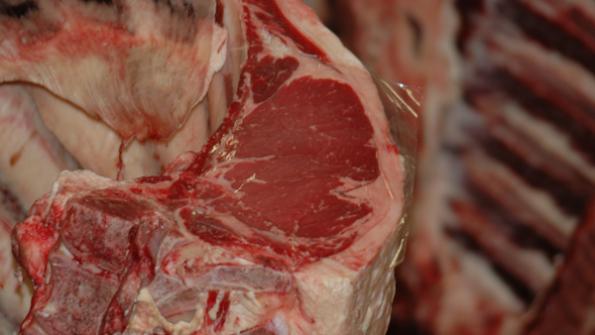Kansas State University To Play Key Role In New $25 Million Beef Safety Research Effort
K-State Teams with Nebraska, other institutions in effort to cut E. coli risk.
January 24, 2012

Seventeen Kansas State University scientists will join researchers from the University of Nebraska-Lincoln and other universities and government agencies in a coordinated, multi-pronged approach to improve the safety of beef.
The $25 million effort will focus on ways to reduce the occurrence and public health risks from Shiga toxin-producing Escherichia coli (STEC), a serious threat to the food supply that results in more than 265,000 infections in the United States each year. Eating contaminated food or direct contact with fecal matter from infected cattle and other ruminants causes most of these illnesses.
The grant was awarded to UNL by the U.S. Department of Agriculture’s National Institute of Food and Agriculture. The team of 48 investigators will be led by UNL veterinary scientist Jim Keen.
“As a national leader in food safety research and education, Kansas State University is pleased to play a major role in a project so vital to the health of the American public,” said Kirk Schulz, K-State president. “As we work toward becoming a top 50 public research university, projects like these showcase our exceptional research track record in this area.”
Randy Phebus, K-State professor of animal sciences and industry will join UNL’s Keen and three others on the overall project’s executive management team. That team will oversee seven inter-related projects that span the five-year life of the grant.
“This USDA-NIFA coordinated agricultural program (CAP) grant shines the light on UNL, K-State and our other collaborators across the country to address one of the most important issues facing the beef industry, Shiga toxin-producing E. coli pathogens, from the calf to the beef consumer,” Phebus said. “STEC management profoundly impacts every beef producer, processor and retailer and it is one of the most relevant public health threats in the food system. The research and education group that we have assembled is world-class and we anticipate many successes during and after the life of this grant that can be practically applied for reducing STEC risks across the beef chain.”
In addition to his role on the management team, Phebus will lead a project focused on improving methods used to detect and control eight types of E. coli (STEC-8) that are most important to public health, including O157:H7, in post-harvest beef processing. The goal is to understand how STEC-8 behaves under different conditions in order to enhance beef processors’ food safety management systems. K-State’s unique Biosecurity Research Institute biocontainment research facility will provide the large-scale laboratory setting for much of this part of the project.
Daniel Thomson, Jones Professor of Production Medicine at K-State, feedlot veterinarian and director of the Beef Cattle Institute, will lead efforts establishing a holistic food safety culture across all sectors of the beef food chain.
“Cattle producers, feedlot operators, transporters, processors, retailers and consumers all must understand and execute their roles in beef safety,” Thomson said. “The BCI will develop and offer training and outreach tools to enhance stakeholder knowledge for all sectors of the beef industry. This will result in a more knowledgeable beef industry workforce and an enhanced beef safety infrastructure.”
Beth Montelone, K-State associate dean and professor of biology, will lead a team that develops training for high school, undergraduate and graduate students that integrates field and laboratory research with university-level education. Internships and externships linked to the project will place students in the laboratories of the grant’s scientists to learn food safety research techniques, with the goal of recruiting students into majors that will provide highly trained food safety professionals to the food industry.
The USDA reported that as of July 2011, there were 100 million head of cattle and calves in the United States. Kansas had 6.3 million head as of Jan. 1, 2011.
In addition to K-State and UNL, participating institutions include: North Carolina State University; the University of California, Davis and Tulare campuses; the University of Delaware; Virginia Polytechnic Institute and State University; the New Mexico Consortium; USDA-Agricultural Research Service; New Mexico State University; Texas A&M University; and the University of Arkansas.
You May Also Like


.png?width=300&auto=webp&quality=80&disable=upscale)
